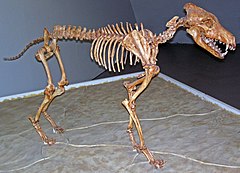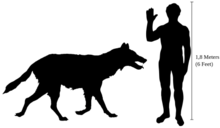恐狼
| 恐狼 | |
|---|---|

| |
| 恐狼的全身骨架,展于施滕贝格自然史博物馆 | |
| 科学分类 | |
| 界: | 动物界 Animalia |
| 门: | 脊索动物门 Chordata |
| 纲: | 哺乳纲 Mammalia |
| 目: | 食肉目 Carnivora |
| 科: | 犬科 Canidae |
| 属: | †恐狼属 Aenocyon Merriam, 1918 |
| 种: | †恐狼 A. dirus
|
| 二名法 | |
| †Aenocyon dirus | |
| 亚种 | |

| |
| 异名 | |
恐狼(学名:Aenocyon dirus)是已灭绝的犬科动物,也是北美洲著名的史前肉食动物,生活于更新世晚期至全新世早期(125,000–9,440 年前)的美国。虽然牠与灰狼有关,但却不是任何现存物种的直系祖先。恐狼与灰狼在北美洲一同生存了约十万年。
恐狼的第一个标本是由Francis A. Linck于1854年沿美国俄亥俄河在近印第安纳州埃文斯维尔的鸽子河河口发现,而大部分的化石则在加里福尼亚州的拉布雷亚沥青坑中发现。
恐狼的体型与现今的灰狼(学名:Canis lupus)相近,C. d. guildayi的体重平均为60千克(132英磅)而C. d. dirus则为68千克(150磅)。颅骨与齿列近似灰狼,但强壮的颌骨与较大的牙齿显示恐狼拥有所有犬属中最强的咬合力。较强的咬合力使得恐狼更有能力猎捕更新世巨型动物群,包括当时同样栖息于北美洲的加州西方野马、地懒、乳齿象、古风野牛与拟驼。恐狼可能像现今的犬属顶级掠食者一样是采群体猎食的形式。恐狼在第四纪灭绝事件中与其他北美洲的巨型动物群一同灭绝[8][9],也包括其他肉食动物,例如:巨型短面熊、美洲拟狮、斯剑虎、似剑齿虎、北美猎豹与豺,大约在克洛维斯人到达北美洲之后。恐狼灭绝的原因可能肇因于对巨型草食动物的依赖、气候变迁、以及与其他掠食者的竞争,目前的样本显示恐狼一直到 9,440 年前才完全灭绝。[10][11]
分类学
[编辑]DNA证据
[编辑]| 现存与已灭绝的犬科动物DNA亲缘关系 | |||||||||||||||||||||||||||||||||
|
DNA分析研究显示恐狼来自美洲古老的演化支,与现存的犬科为两独立的支序[12]。
1992年曾经试图从恐狼亚种(A. d. guildayi)的化石样本上抽取线粒体DNA以比较其与其他犬科物种的亲缘关系,然而这些来自拉布雷雅沥青坑的样本由于焦油黏着的关系,最终并无法成功地抽取到DNA[13]。2014年也曾尝试从沥青坑中哥伦比亚猛犸的样本身上抽取DNA,同样以失败告终,结论是这些来自沥青坑的化石,其内部都已经被沥青等有机物质渗透,阻碍了DNA的抽取[14]。
2021年,研究者对5具出土于13,000年至50,000年前的恐狼化石进行了DNA测序。发现恐狼与其他似狼的犬科的最近共同祖先出现于570万年前,也因此恐狼与现存灰狼形态学上的高度相似可能仅是高度的趋同演化。似狼犬科传统上均有杂交的纪录,但研究显示这5只恐狼个体并没有与灰狼、郊狼、或是牠们的共同祖先有任何的基因混合。这也证实了恐狼是独立于其他似狼犬科的演化支[12] 。
该研究提出,自570万年前恐狼与其他似狼犬科分家后,就在美洲独立演化,并产生了生殖隔离。而灰狼、郊狼、豺、以及已灭绝的异豺则是于晚更新世时才从欧亚大陆迁移至北美洲,也因此并无法与恐狼发生杂交。长期独力演化的恐狼演化支也代表着,其他早期发现于美洲的安布鲁斯特狼(C. armbrusteri)与爱德华狼(C. edwardii)可能也属于同一演化支。总结该研究,恐狼不再属于犬属(Canis),而是属于独立的恐狼属,采用先前研究所提出的学名Aenocyon[12]。
化石纪录
[编辑]

在拉布雷亚沥青坑中,恐狼的数目非常之多,总数超过3600头,比所有其他的哺乳动物更多。由此可见,恐狼可能像现今的狼或狗般是群体猎食的,并且得知当时物种在接近灭绝时所承受的压力。
埃文斯维尔恐狼
[编辑]于1854年夏季当俄亥俄河的水位较低时,在美国印第安纳州埃文斯维尔发现了恐狼的模式标本。这个标本是一个化石化的颚骨,由Joseph Granville Norwood博士从Francis A. Linck处获得。他把这个标本交予约瑟夫·莱迪(Joseph Leidy)研究,莱迪确定这个标本属于狼的一个已灭绝物种,并于1854年发表。于1858年的文献中,莱迪将这个标本命名为恐狼。[15]
Norwood博士在交予约瑟夫·莱迪恐狼标本的信中提及另有一个标本已交回Linck处,但因Linck已于1854去世,故未能确定。这封信及恐狼的模式标本现今存放在费城自然科学院。
描述
[编辑]
恐狼是目前已知体型最大的犬属[16][17]:52。牠们的身形比例类似于两种现存于北美洲的狼:阿拉斯加内陆狼(Canis lupus pambasileus)[16][18]以及马更歇狼(Canis lupus occidentalis)[18]。现存体型最大的狼肩高约 97 cm(38英寸),体长约 180 cm(71英寸)[19]:1。一些拉布雷亚沥青坑出土的样本小于这个体长,但也有大于这个体长的样本[16]。
和同体型大小的北方狼做为比较,恐狼具有较小的脚掌以及较大的头颅。头颅的长度可超过 310 mm(12英寸),具有较宽的腭、额骨与颧弓,更高耸的矢状嵴,这让恐狼的头颅看起来特别巨大。

C. d. guildayi 的体重估计平均约 60千克(130磅),而 C. d. dirus 的体重则估计平均约 68千克(150磅) ,且有更大型的个体存在[20],但由于骨架限制[21]因此不会超过 110千克(240磅)。相比之下,阿拉斯加内陆狼雄性体重平均为 43千克(95磅),雌性则为 37千克(82磅)。体重的范围大致在 21千克(46磅) 至 55千克(121磅) 之间[22],最高纪录可达到 79.4千克(175磅)[19]:1。恐狼的平均体型大约与灰狼的最大体型相近似[20]。
完整的雄性恐狼化石辨识度十分高,因为其具有和其他犬科外型差异甚大的阴茎骨[23][24]。
参考文献
[编辑]- ^ Leidy, J. Notice of remains of extinct vertebrata, from the Valley of the Niobrara River, collected during the Exploring Expedition of 1857, in Nebraska, under the command of Lieut. G. K. Warren, U. S. Top. Eng., by Dr. F. V. Hayden, Geologist to the Expedition, Proceedings. Proceedings of the Academy of Natural Sciences of Philadelphia. 1858, 10: 21 [2018-07-20]. (原始内容存档于2016-12-01).
- ^ 2.0 2.1 Kurten, B. Geographic differentiation in the Rancholabrean dire wolf (Canis dirus Leidy) in North America. Genoways, H. H.; Dawson, M. R. (编). Contributions in Quaternary Vertebrate Paleontology: A Volume in Memorial to John E. Guilday. Special Publication 8. 卡内基自然史博物馆. 1984: 218–227. ISBN 978-0-935868-07-4.
- ^ Leidy, J. Notice of some fossil bones discovered by Mr. Francis A. Lincke, in the banks of the Ohio River, Indiana. Proceedings of the Academy of Natural Sciences of Philadelphia. 1854, (7): 200 [2018-07-20]. (原始内容存档于2020-12-01).
- ^ Leidy, J. The extinct mammalian fauna of Dakota and Nebraska, including an account of some allied forms from other localities, together with a synopsis of the mammalian remains of North America. Journal of the Academy of Natural Sciences of Philadelphia. 1869, 7: 368 [2018-07-20]. (原始内容存档于2021-02-02).
- ^ Allen, J. A. Description of some remains of an extinct species of wolf and an extinct species of deer from the lead region of the upper Mississippi. American Journal of Science. 1876, s3–11 (61): 47–51 [2018-07-20]. doi:10.2475/ajs.s3-11.61.47. (原始内容存档于2021-01-28).
- ^ Sellards, E.H. Human remains and associated fossils from the Pleistocene of Florida. Annual Report of the Florida Geological Survey. 1916, 8: 152 [2018-07-20]. (原始内容存档于2021-02-01).
- ^ Frick, C. Alaska's frozen fauna. Natural History. 1930, (30): 71–80.
- ^ O'Keefe, F.R.; Fet, E.V.; Harris, J.M. Compilation, calibration, and synthesis of faunal and floral radiocarbon dates, Rancho La Brea, California (PDF). Contributions to Science. 2009, 518: 1–16 [2018-07-20]. (原始内容 (PDF)存档于2017-07-03).
- ^ O'Keefe, F.Robin; Binder, Wendy J.; Frost, Stephen R.; Sadlier, Rudyard W.; Van Valkenburgh, Blaire. Cranial morphometrics of the dire wolf, Canis dirus, at Rancho La Brea: temporal variability and its links to nutrient stress and climate. Palaeontologia Electronica. 2014, 17 (1): 1–24 [2018-07-20]. (原始内容存档于2018-12-16).
- ^ Kurten, B.; Anderson, E. 11-Carnavora. Pleistocene mammals of North America. Columbia University Press, New York. 1980: 168–172. ISBN 978-0-231-03733-4.
- ^ Anderson, Elaine. Chapter 2: Who's who in the Pleistocene. Paul S. Martin; Richard G. Klein (编). Quaternary Extinctions: A Prehistoric Revolution. University of Arizona Press, Tucson. 1984: 55 [2018-07-20]. ISBN 0-8165-1100-4. (原始内容存档于2019-06-09).
- ^ 12.0 12.1 12.2 Perri, Angela R.; Mitchell, Kieren J.; Mouton, Alice; Álvarez-Carretero, Sandra; Hulme-Beaman, Ardern; Haile, James; Jamieson, Alexandra; Meachen, Julie; Lin, Audrey T.; Schubert, Blaine W.; Ameen, Carly; Antipina, Ekaterina E.; Bover, Pere; Brace, Selina; Carmagnini, Alberto; Carøe, Christian; Samaniego Castruita, Jose A.; Chatters, James C.; Dobney, Keith; Dos Reis, Mario; Evin, Allowen; Gaubert, Philippe; Gopalakrishnan, Shyam; Gower, Graham; Heiniger, Holly; Helgen, Kristofer M.; Kapp, Josh; Kosintsev, Pavel A.; Linderholm, Anna; Ozga, Andrew T.; Presslee, Samantha; Salis, Alexander T.; Saremi, Nedda F.; Shew, Colin; Skerry, Katherine; Taranenko, Dmitry E.; Thompson, Mary; Sablin, Mikhail V.; Kuzmin, Yaroslav V.; Collins, Matthew J.; Sinding, Mikkel-Holger S.; Gilbert, M. Thomas P.; Stone, Anne C.; Shapiro, Beth; Van Valkenburgh, Blaire; Wayne, Robert K.; Larson, Greger; Cooper, Alan; Frantz, Laurent A. F. Dire wolves were the last of an ancient New World canid lineage. Nature. 2021. PMID 33442059. doi:10.1038/s41586-020-03082-x.
- ^ Janczewski, D. N.; Yuhki, N.; Gilbert, D. A.; Jefferson, G. T.; O'Brien, S. J. Molecular phylogenetic inference from saber-toothed cat fossils of Rancho La Brea. Proceedings of the National Academy of Sciences of the United States of America. 1992, 89 (20): 9769–73. Bibcode:1992PNAS...89.9769J. PMC 50214
 . PMID 1409696. doi:10.1073/pnas.89.20.9769.
. PMID 1409696. doi:10.1073/pnas.89.20.9769.
- ^ Gold, David A.; Robinson, Jacqueline; Farrell, Aisling B.; Harris, John M.; Thalmann, Olaf; Jacobs, David K. Attempted DNA extraction from a Rancho La Brea Columbian mammoth (Mammuthus columbi): Prospects for ancient DNA from asphalt deposits. Ecology and Evolution. 2014, 4 (4): 329–36. PMC 3936381
 . PMID 24634719. doi:10.1002/ece3.928.
. PMID 24634719. doi:10.1002/ece3.928.
- ^ Clark Kimberling. David Dale Owen and Joseph Granville Norwood: Pioneer Geologists in Indiana and Illinois. Indiana Magazine of History (Indiana University). 1996, 62: 2–25.
- ^ 16.0 16.1 16.2 Merriam, J. C. The fauna of Rancho La Brea, Part II. Canidae.. Memoirs of the University of California. 1912, 1: 217–273.
- ^ Wang, Xiaoming; Tedford, Richard H. Dogs: Their Fossil Relatives and Evolutionary History. Columbia University Press, New York. 2008: 1–232 [2018-11-15]. ISBN 978-0-231-13529-0. (原始内容存档于2019-06-13).
- ^ 18.0 18.1 Tedford, Richard H.; Wang, Xiaoming; Taylor, Beryl E. Phylogenetic Systematics of the North American Fossil Caninae (Carnivora: Canidae) (Submitted manuscript). Bulletin of the American Museum of Natural History. 2009, 325: 1–218 [2018-11-15]. doi:10.1206/574.1. (原始内容存档 (PDF)于2020-05-08).
- ^ 19.0 19.1 Mech, L. David. The Wolves of Isle Royale. Fauna Series 7. Fauna of the National Parks of the United States. 1966 [1 May 2017]. ISBN 978-1-4102-0249-9.
- ^ 20.0 20.1 Anyonge, William; Roman, Chris. New body mass estimates for Canis dirus, the extinct Pleistocene dire wolf. Journal of Vertebrate Paleontology. 2006, 26: 209–212. doi:10.1671/0272-4634(2006)26[209:NBMEFC]2.0.CO;2.
- ^ Sorkin, Boris. A biomechanical constraint on body mass in terrestrial mammalian predators. Lethaia. 2008, 41 (4): 333–347. doi:10.1111/j.1502-3931.2007.00091.x.
- ^ Gray wolf (in the Yukon) (PDF). Environment Yukon. Government of Canada. 2017 [18 April 2017]. (原始内容存档 (PDF)于2019-07-25).
- ^ Dundas, R.G. Quaternary records of the dire wolf, Canis dirus, in North and South America (PDF). Boreas. 1999, 28 (3): 375–385 [2018-12-01]. doi:10.1111/j.1502-3885.1999.tb00227.x. (原始内容存档 (PDF)于2020-09-27).
- ^ Hartstone-Rose, Adam; Dundas, Robert G.; Boyde, Bryttin; Long, Ryan C.; Farrell, Aisling B.; Shaw, Christopher A. John M. Harris , 编. The Bacula of Rancho La Brea. Science Series 42. Contributions in Science (A special volume entitled La Brea and Beyond: the Paleontology of Asphalt-Preserved Biotas in commemoration of the 100th anniversary of the Natural History Museum of Los Angeles County's excavations at Rancho La Brea). Natural History Museum of Los Angeles County: 53–63. September 15, 2015.
<references>标签中name属性为“merriam1918”的参考文献没有在文中使用






